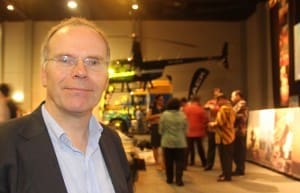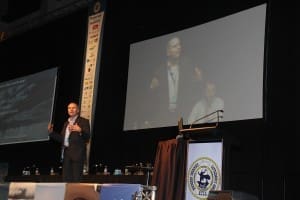It takes a brave man to fly half way around the world to tell a room full of Northern Territory cattle producers that what they do is bad for the planet, and that the meat they produce could be replaced by lab grown meat within a few decades.
But rather than getting headlocked in a bull catcher and run out of town, Dutch scientist Dr Mark Post received a calm and engaged hearing when he told the NT Cattlemen’s Association Conference last Friday why he believes meat stem cells can feed the world.
It couldn’t be said local producers agreed with his base position that grassfed cattle production is an inefficient way to convert vegetable protein into animal protein, particularly in low-rainfall grasslands were no better alternative to grazing cattle has yet been found to convert grass into food for human consumption.
And while talk of growing meat in test tubes may have left some feeling slightly squeamish, nor did producers who spoke to Beef Central after the speech say they feel necessarily threatened by the technology Dr Post is pioneering.
Rather, as reinforced by several market outlook presentations during last Friday’s conference, and acknowledged by Dr Post himself, demand for beef around the world is so strong in comparison to global supply that the consensus view is that the world will need every bit of meat that can be produced to feed the growing global masses, both with naturally produced beef and lab grown alternatives (see Dr Ross Ainsworth’s comments at bottom of this article).
Read more stories from the NTCA conference here
Dr Post made global headlines 18 months ago when he produced the world’s first hamburger patty grown entirely from meat stem cells.
He told Friday’s NTCA conference that meat grown in a laboratory is vastly more efficient to produce in terms of energy use, greenhouse gas emissions, land use and water use than conventional cattle production.
While mass-produced, cheaply-priced, lab-grown meat is still likely to be more than a decade away, Dr Post said he has no doubt it will happen.
It should be noted that Dr Post is not “anti-meat”. He told the audience he is not a vegetarian, and acknowledged that humans as a species are “designed to love meat”.
His focus, rather, is on finding a less resource intensive way to help the world produce enough meat to feed a projected 70pc increase in global demand for meat in the next 35 years.
He added that there is no medical reason why humans need animal protein to live. Two billion people on planet earth prove every day that you don’t. “They live happy and healthy lives and there is really no reason that we should eat beef, other than that we really like it.”
He also acknowledges that a world-scale conversion to vegetarianism is unlikely, particularly in countries such as China and India where middle class income earners can now afford to eat meat for the first time, and see it as a status symbol.
So how does his process of growing lab grown meat work? A précis of Dr Post’s explanation last Friday goes something like this: muscle stem cells, which have the capacity to replicate and form muscle, are removed from an animal and multiplied in a petri-dish. The cells are stored for several weeks in a gel-like support structure, which is derived from cows, and fed a feotal bone serum. Stimulation from electrical currents helps to generate tension and exercise for te cells, and in turn creates the proteins which turn tissue into bona fide muscle fibres. Each fibre by this point is around 2.5cm long by 1mm in diameter. Produce around 10,000 of these, arrange them in a pattie with some salt and breadcrumbs, and you have a lab produced hamburger.
The meat tissue grown in the lab is no different to meat tissue in conventionally raised beef, Dr Post says. “Genetically nothing has changed. It is just that we grow it outside of an animal, instead of inside.”
Dr Post said he decided to show the burger to the world 18 months ago, not because the product was perfected – he readily acknowledges it wasn’t – but to demonstrate that the technology now exists and that “this is possible”.
“Let’s think about this, let’s think about how we can make this happen,” he said.
The first lab grown burger cost around A$400,000 to produce. It tasted “okay”, Dr Post said, but was a little dry and lacked enough fat. But he also has no doubt that the technology is refined and with the use of 3D printing techniques that his team will soon be able to build a full thickness steak this way.
Producing cultured beef in large enough volumes to bring down its cost per kilogram is the next challenge.
Scaling the technology up from a small 1 litre tank to a 25,000 litre bioreactor – the next phase of the project – is expected to bring the price down to $US65/kg within three to four years.
Then the price really starts to look competitive: “The numbers that we use in this modeling are such that we think that in the five or 10 years after that this price can come down 10-fold,” Dr Post explained.
“So then you are down to $6/kg. If you go to $4-$5/kg, then it will sort of get in the range where you want it to go.
“I think this is something that will happen, it is not going to happen in the next five years, but we are planning to put a product on the market somewhere within 5-10 years.
“So it is not complete science fiction.”
The real challenge of is how consumers will react to the product.
If people can’t get over the “ick” or the “yuck” factor and won’t eat it, then what’s the point?
Dr Post is has no doubt this hurdle will be overcome. For a start, consumers have already demonstrated they are perfectly willing to eat things even when they don’t know what that food contains.
He points to sausages as an obvious example. Many people think sausages contain organ tissue, or all the “junk that comes off the slaughter house floor”, yet they still eat them.
“The point is not that they eat it, it is that they eat it when they don’t know what is in it,” Dr Post said.
“So we are perfectly willing to eat stuff that we don’t know exactly what it is, (provided) we think it is safe.”
Also, he says, consumers like to feel control over how their food is produced. He believes lab grown meat offers more control and certainty over how their food is producers than consumers have ever had.
A recent survey in the Netherlands polled a cross section of the population on whether they would eat lab grown meat. More than 50pc said they would, and the same amount said they would or were likely to buy it if it was available in the supermarket.
“This was surprising to us that there is a willingness out there to look at new stuff, if you explain what the potential benefits are.”
In a later presentation at Friday’s NTCA conference, Dr Ross Ainsworth said he did not see lab grown and 3D printed beef as a threat to conventional beef production.
“The world is going to need all of those things, every single bit of technology that is available will be absolutely essential in order to feed people,” Dr Ainsworth said.
“They’re not a threat, they’re an add on,” he said, adding that by the time lab grown beef is available in the supermarket, a global supply shortfall could have pushed liveweight cattle prices much, much higher than now.






HAVE YOUR SAY